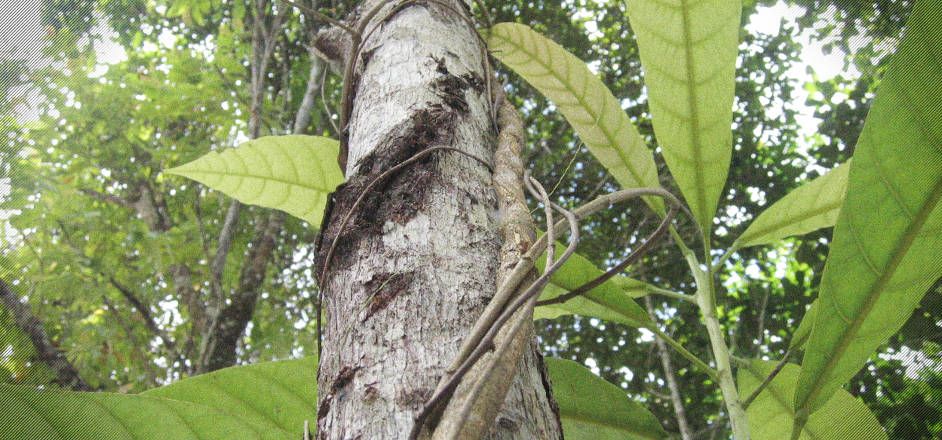Ayahuasca is a vine that climbs trees in the Amazon. For the past couple decades, it's been climbing its way into American culture.
Jungle shamans claim the tea made from ayahuasca gives them supernatural powers. In the 1950s, American seekers hacked through the Amazon and demanded a sip. After gulping the terrible-tasting swill, they found that aya is like loading the universe into a cannon and firing it at your brain. Then they slept in the mud.
Today, after decades of exposure, you can find ayahuasca on Yelp.
On Yelp Orlando, Soul Quest Ayahuasca Church of Mother Earth, where you drink the brew in a big group of gringos in a suburban backyard, boasts that it's "just 20 minutes from the airport."
On Yelp Los Angeles, The Holistic Sanctuary, a super lux 5-star aya retreat, boasts the farthest thing from sleeping in huts. Most Yelp reviewers love that it is right on the ocean, with yoga classes, a hyperbaric chamber and IV infusions. Few blinked at the cost: $25,000 for a two week retreat.
Aya illustrates how America's drug tastes are changing. We are branching out from the old standby drugs: alcohol, weed and tobacco. From African Iboga to the Mexican magic mushroom, a lot of brain-busting powders, pills and brews that were once covered by shadows are coming into the light.
Aya, like a lot of drugs, exists in a legal gray area, not strictly legal or illegal, so most aya ceremonies are under the radar. But if you keep your ears open, you see it everywhere. New centers open. Roving ceremonies bring curanderos (healers) from Peru and Ecuador. Informal gatherings in living rooms and AirBnBs. Teens cook up their own brews with vines and leaves they got off the Internet.
Science keeps suggesting it has some of the most wide-ranging benefits of any drug, and relatively few side effects. During a trip, blood flows differently and brain cells regrow. And, after, folks overcome eating disorders and say goodbye! to depression. Unproven claims say it fights cancer and prevents brain death.
Don't let folks tell you it's entirely about health or contacting forces beyond understanding. It's also a ball pit of fun. Wilder ride than anything at Six Flags, with more insanely cool 3D movie effects than an IMAX. Usually, you feel very happy on it. In terms of drinks to have on a Saturday night, this brew beats Coors Light by a factor of 100.
It's not everywhere, yet, but it's close. Brooklynites in scarves chug aya as casually as Minnesotans shotgun beers. Friends do it as birthday celebrations. The shamans aren't always grizzled jungle Natives with leathery skin; they are sometimes hip white dudes in beards and fedoras, youngish white women pictured doing semi-naked yoga poses.
It comes from the Amazon villages, but it's bougie as fuck now. A San Francisco outfit calling itself Entrepreneurs Awakening features Silicon Valley types bragging that aya helped them double their sales. It's perilously close to Onion satire: "Ayahuasca Shaman Dreading Another Week Of Guiding Tech CEOs To Spiritual Oneness."
Celebrities chart private jets into the Amazon to try it in "authentic" lodges, featuring those old Amazonian practices: yoga, pilates and raw juice bars. Avicii Instagrammed it. Miley Cyrus and Sting sung its praises. Jane Fonda did aya, so did Chelsea Handler; Natalie Portman rapped about her brain gone on aya on SNL. Lindsay Lohan says aya helped her. (It's not clear, then, why she's still such a mess.)
Aya is not entirely high-class, or celeb. In Wyoming, "preppers" — country folk preparing for the end of the world by stockpiling food and guns — have been holding aya ceremonies in their underground home. In Kentucky, an ayahuasca church holds ceremonies in the leader's garage.
But aya is so pervasive that it has become shorthand in the culture for "life-changing, eye-opening medicine."
Although: aya can also be shorthand for: "brain-scrambler." Because there are serious negative side effects. People go manic on it. Mental health pros suggests "people with personal or family history of psychotic disorders should avoid aya."
Difficult aya trips are as terrifying as anything in life: visions of skeleton demons pulling you to hell, hallucinations of neon-colored gods smashing you to death with rocks. (You get over these.)
Plus, there's the stomach trouble. You sit with folks having a spiritual experience, and you can tell how intensely they are feeling transcendence by how far their projectile vomit is arcing and how audibly they're shitting their pants.
Of course, everything about this commercialized, globalized, gringo-ized, scientific ayahuasca explosion pissed off natives Amazonians, who feel like modern aya culture ripped out their hearts and sold it on Fifth Avenue. "Cultural appropriation, denigration, desecration," they say. They protest loudly at conferences.
To these charges, some gringos say: well, ok, sorry, but it works, and we'll stop using your ancient plant medicine when you stop using our iPhones and penicillin.
Natives might have to get used to it this offense. Aya in the West ain't going anywhere. Because aya is less fun than other drugs, but makes people happier afterward, it's like the Crossfit of drugs, the Tough Mudder of drugs.
It might not be the future of psychedelic drugs — it's too weird for that, and too physically uncomfortable.
But because aya sits at the intersection of so many American issues: pharmacology and mental health, spirituality and addiction, God and nature, cultural exploitation and globalization, celebrity and social media — it might be the drug of this moment. The medicine of choice for some very strange times.



Leave a Reply
You must be logged in to post a comment.